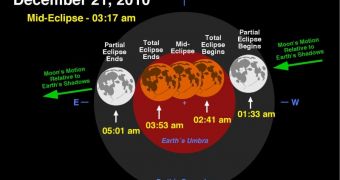The winter solstice will be arriving on December 21 this year, and most people probably won't even remember it, so here is another reason to circle the date in your calendar (or mark it on your phone): the same night, a total lunar eclipse will be visible too.
Sky watchers across North America, Greenland and Iceland, should be able to admire it early in the morning on December 21, while those in western states should start seeing it late in the evening of December 20.
In Western Europe, the early stages of the eclipse should be visible before moonset, and in western Asia the later stages of the eclipse will be visible after moonrise.
Overall, the moon eclipse will last about three hours and twenty-eight minutes, in other words, for observers on the east coast of the United States the eclipse lasts from 1:33am EST through 5:01 am EST.
On the west coast, the show will begin a bit earlier – it starts at 10:33 pm PST on December 20 and lasts until 2:01am PST on December 21.
A lunar eclipse occurs when the Earth lines up directly between the sun and the moon, blocking the sun's rays and casting a shadow on the moon, which this year will completely cover it for 72 minutes.
While the moon is covered by the shadow, it changes color before your eyes, turning from gray to orange and a deep shade of red.
This occurs because sunlight can still pass through the Earth's atmosphere and glow on the moon, it's just that the atmosphere filters most of the blue-colored light, and leaves the orange and red hues.
When the moon appears in a darker shade of red, it's because of the extra particles in the atmosphere, like from a recent volcanic eruption, for example.
The good news is that, unlike solar eclipses, lunar eclipses can be seen without any special equipment or glasses, since it's perfectly safe.
So if you are curious, you could stay up late and watch what should be an amazing show, especially since the next time you'll get the chance of seeing something like this will be April 15, 2014, according to NASA.
Update:
This month there is another phenomenon that you should not miss – the December Ursids, a meteor shower that will peak in the night of December 22 to December 23.
Normally, you would have a very hard time seeing them since during this period, the full moon shines very bright in the night sky, according to SPACE.com.
But hey, all you skywatchers out there are lucky this year since the rare lunar eclipse on the night of December 20 to December 21 could offer you a chance to catch a glimpse of the Ursid meteor shower.
Since during the eclipse, the moon will appear 10,000 to 100,000 times dimmer than usual, it will allow many of the fainter stars and even the Milky Way to temporarily appear, and we can only hope that a few Ursid meteors will be visible too!

 14 DAY TRIAL //
14 DAY TRIAL //